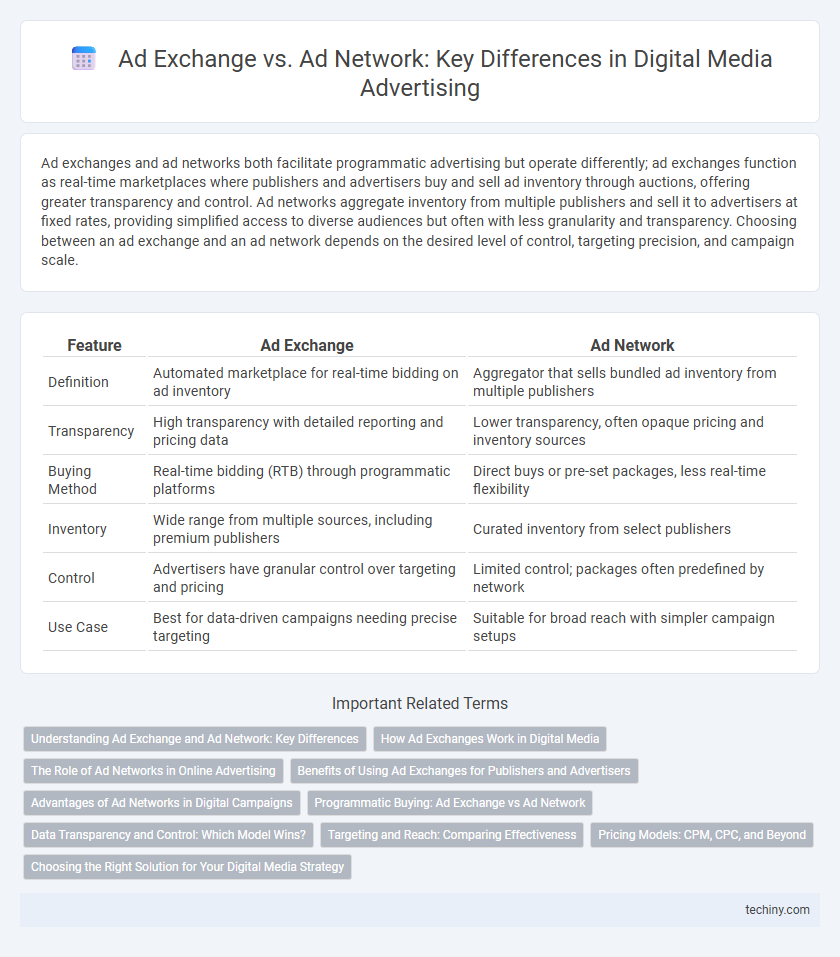Ad exchanges and ad networks both facilitate programmatic advertising but operate differently; ad exchanges function as real-time marketplaces where publishers and advertisers buy and sell ad inventory through auctions, offering greater transparency and control. Ad networks aggregate inventory from multiple publishers and sell it to advertisers at fixed rates, providing simplified access to diverse audiences but often with less granularity and transparency. Choosing between an ad exchange and an ad network depends on the desired level of control, targeting precision, and campaign scale.
Table of Comparison
| Feature | Ad Exchange | Ad Network |
|---|---|---|
| Definition | Automated marketplace for real-time bidding on ad inventory | Aggregator that sells bundled ad inventory from multiple publishers |
| Transparency | High transparency with detailed reporting and pricing data | Lower transparency, often opaque pricing and inventory sources |
| Buying Method | Real-time bidding (RTB) through programmatic platforms | Direct buys or pre-set packages, less real-time flexibility |
| Inventory | Wide range from multiple sources, including premium publishers | Curated inventory from select publishers |
| Control | Advertisers have granular control over targeting and pricing | Limited control; packages often predefined by network |
| Use Case | Best for data-driven campaigns needing precise targeting | Suitable for broad reach with simpler campaign setups |
Understanding Ad Exchange and Ad Network: Key Differences
Ad exchanges function as real-time marketplaces where advertisers bid on ad inventory from multiple publishers, enabling automated, dynamic buying and selling of digital ads. Ad networks aggregate ad space from various publishers and sell it directly to advertisers, often providing targeted ad placements but with less real-time flexibility. The primary difference lies in the transparency and bidding process, with ad exchanges offering programmatic, auction-based transactions, while ad networks typically operate on pre-negotiated terms and fixed prices.
How Ad Exchanges Work in Digital Media
Ad exchanges function as automated digital marketplaces where publishers and advertisers buy and sell ad inventory through real-time bidding, enabling dynamic pricing based on demand and audience targeting. Unlike ad networks that aggregate inventory privately, ad exchanges offer greater transparency and access to a broader range of impressions across multiple publishers. This programmatic buying process enhances efficiency and ensures advertisers reach specific audiences with precision at scale.
The Role of Ad Networks in Online Advertising
Ad networks aggregate inventory from multiple publishers to sell targeted advertising space, leveraging sophisticated data segmentation to optimize campaign performance. Their role in online advertising centers on simplifying the buying process for advertisers, providing access to diverse audience segments through consolidated platforms. By offering real-time bidding and enhanced targeting capabilities, ad networks improve the efficiency and reach of digital ad campaigns compared to traditional methods.
Benefits of Using Ad Exchanges for Publishers and Advertisers
Ad exchanges offer publishers greater transparency and real-time bidding, maximizing revenue through dynamic inventory sales. Advertisers benefit from precise audience targeting and access to diverse publisher inventory, enhancing campaign efficiency. The programmatic nature of ad exchanges reduces operational costs and increases scalability compared to traditional ad networks.
Advantages of Ad Networks in Digital Campaigns
Ad networks provide streamlined access to a wide range of publishers, allowing advertisers to reach diverse target audiences efficiently. They offer centralized campaign management and optimization tools that enhance ad performance and budget allocation. By aggregating inventory, ad networks simplify media buying and improve cost-effectiveness for digital campaigns.
Programmatic Buying: Ad Exchange vs Ad Network
Programmatic buying in digital media involves automated ad purchasing through platforms like Ad Exchanges and Ad Networks. Ad Exchanges offer real-time bidding, providing advertisers access to a broad inventory with dynamic pricing, enhancing targeting precision and budget efficiency. In contrast, Ad Networks aggregate publisher inventory with fixed pricing models, offering streamlined campaign management but less flexibility compared to Ad Exchanges in programmatic environments.
Data Transparency and Control: Which Model Wins?
Ad exchanges offer greater data transparency and control by facilitating real-time bidding and direct access to multiple advertisers, enabling publishers to optimize inventory monetization. Ad networks aggregate inventory and often limit visibility into detailed audience data and bidding processes, reducing control for publishers over ad placements. Consequently, ad exchanges typically win in providing superior transparency and control for data-driven digital media strategies.
Targeting and Reach: Comparing Effectiveness
Ad Exchange offers real-time bidding with highly granular targeting options, enabling advertisers to reach specific audience segments across multiple platforms efficiently. Ad Network aggregates inventory from various publishers but often provides broader, less precise targeting capabilities compared to the programmatic nature of Ad Exchanges. The advanced targeting precision of Ad Exchanges typically results in higher campaign effectiveness and optimized reach for advertisers seeking specific demographics.
Pricing Models: CPM, CPC, and Beyond
Ad Exchange platforms enable real-time bidding, offering dynamic pricing models such as CPM (Cost Per Mille), CPC (Cost Per Click), and CPA (Cost Per Acquisition) that provide advertisers with flexible, data-driven campaign management. In contrast, Ad Networks typically use fixed or negotiated CPM and CPC rates, aggregating inventory to simplify purchasing but often with less granular control over pricing. Understanding the differences in pricing models between Ad Exchanges and Ad Networks is crucial for optimizing media spend and maximizing return on investment in digital advertising.
Choosing the Right Solution for Your Digital Media Strategy
Ad Exchanges offer real-time bidding and access to a wide range of inventory, enabling granular targeting and dynamic pricing suitable for campaigns requiring flexibility and scale. Ad Networks aggregate publisher inventory, providing curated audiences and simple buying processes ideal for advertisers seeking ease and brand-safe environments. Selecting between Ad Exchange and Ad Network depends on campaign goals, budget size, and the need for transparency versus convenience in your digital media strategy.
Ad Exchange vs Ad Network Infographic

 techiny.com
techiny.com